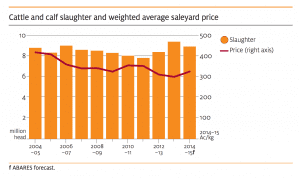The latest quarterly commodity report released by ABARES yesterday highlights just how precariously balanced the current outlook is for many Australian cattle producers.
The spring/summer is shaping as a make or break period for most producers, with rain the key regulating factor that will tilt the scales either way.
If a good spring-summer rainfall season eventuates, ABARES expects the saleyard price average to increase by 12pc to 328c/kg dressed weight in 2014-15 compared to last financial year.
This rise will be driven by a shortage of cattle relative to demand, as producers rebuild herds and also increase demand for restocker cattle.
However, if seasonal conditions fail to improve, the picture is less rosy.
Average saleyard prices would likely be ‘markedly lower’ than the 328c/kg forecast, ABARES says, as drought conditions worsen and force producers to continue liquidating their herds.
The chances of either of the above two scenarios eventuating are currently rated at roughly equal for most major cattle producing areas, according to the Bureau of Meteorology’s September to November 2014 rainfall outlook issued in late August.
Overall ABARES is expecting Australian cattle slaughter rates and beef exports to remain high during the 2014-15 financial year.
Key beef forecasts for 2014-15:
- Australian beef exports are forecast to ease by 5pc to 1.11 million tonnes (slightly short of last year’s record 1.18 million tonnes).
- The Australian beef cattle herd is set to fall to a five-year low of 24.2 million head, reflecting two years of soaring slaughter rates and resurgent live export shipments.
- Australia is expected to again slaughter more than 9 million cattle in 2014-15 (down by 5pc on the 35-year high 9.5m head in 2013-14), and is expected to export more than 1 million cattle.
- Australian beef and veal production is forecast to fall by 3pc to 2.4 million tonnes.
- The United States is set to become the largest buyer of Australian beef in 2014-15, overtaking Japan which has held the position for the past 12 years.
- The bureau believes the United States with import 290,000 tonnes of Australian beef and Japan will import 265,000 tonnes.
- Australian beef and veal exports to China are forecast to remain largely unchanged at around 160 000 tonnes (shipped weight), with growth to be constrained by reduced supply of Australian beef available for export.
- Australia is not expected to export beef and veal to the world’s biggest beef importer, the Russian Federation, in 2014–15 as a result of a one-year embargo placed on imports from countries that imposed sanctions on the Russian Federation for its actions in eastern Ukraine.
To view the full report on the ABARES website click here




HAVE YOUR SAY